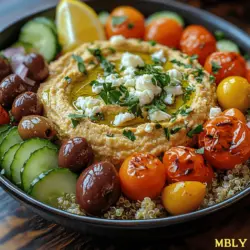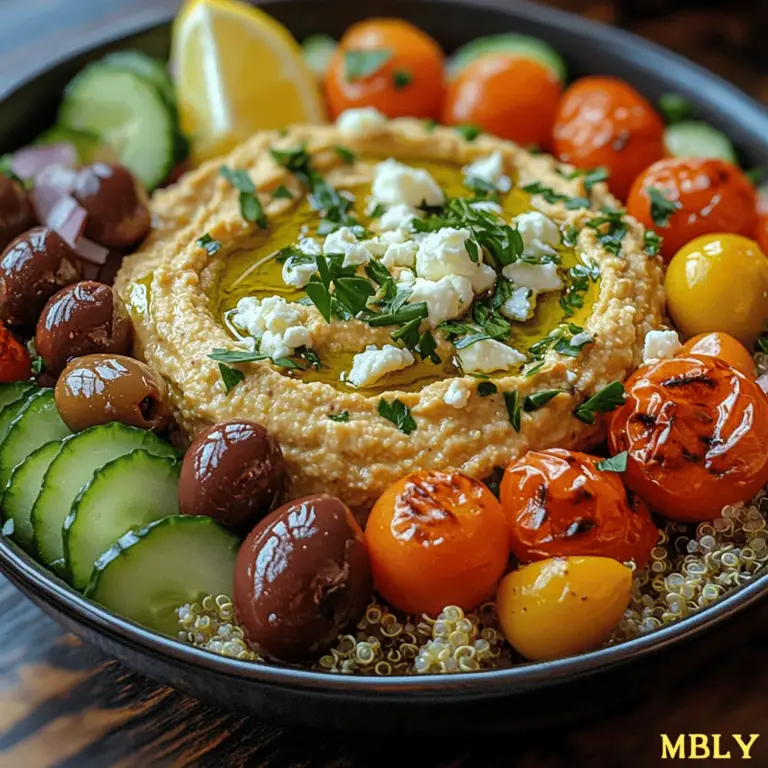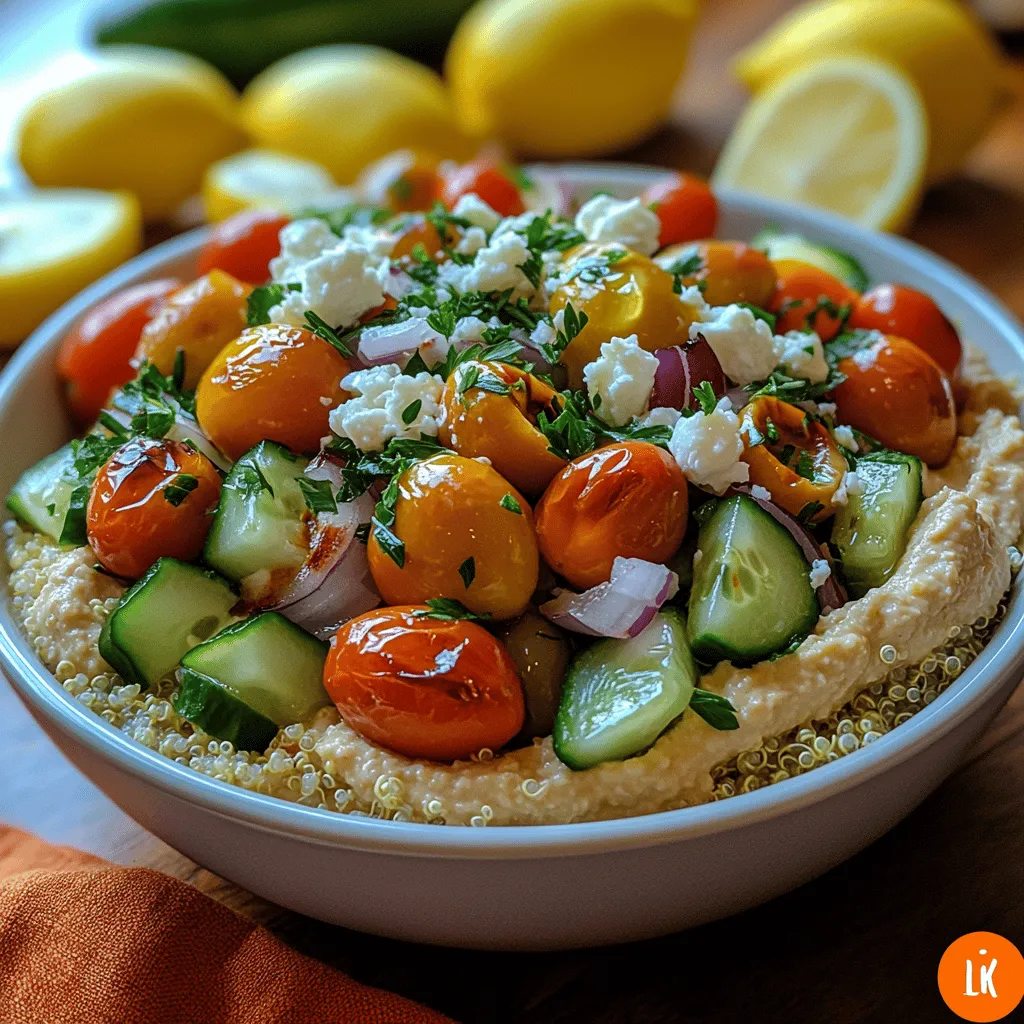Introduction
Hummus has emerged as a beloved staple in various cuisines worldwide, transcending its Middle Eastern origins to become a versatile and universally adored dip. Its creamy texture and rich flavor profile make it an appealing choice for health-conscious eaters and culinary enthusiasts alike. Traditionally made from chickpeas, tahini, lemon juice, and a blend of spices, hummus serves as an excellent companion to an array of dishes, from pita bread to fresh vegetables, and even as a spread on sandwiches. Today, we’re diving into a delightful twist on the classic hummus: Roasted Garlic Hummus Bowls.
These bowls are not just a dish; they offer an explosion of flavor and nutrition, all while being incredibly easy to make at home. By roasting garlic, you can elevate the taste of your hummus to new heights, adding a sweet and savory depth that perfectly complements the creamy chickpeas. The Roasted Garlic Hummus Bowl is not only a feast for the palate but also a canvas for creativity, allowing you to customize the ingredients based on your preferences, dietary needs, and seasonal availability.
In this article, we’ll explore the health benefits of homemade hummus, the versatility of its ingredients, and the steps to create the perfect Roasted Garlic Hummus. Whether you’re preparing a light lunch, a snack for entertaining, or a wholesome dinner, this recipe will surely become a favorite in your household.
Understanding the Ingredients
Creating Roasted Garlic Hummus Bowls starts with understanding the key ingredients that make this dish both nutritious and flavorful. Each component not only contributes to the overall taste but also brings a wealth of health benefits to the table.
Roasted Garlic
Garlic is often celebrated for its distinct flavor and numerous health properties. When roasted, garlic transforms from a pungent raw ingredient into a sweet, caramelized delight. This magical change enhances its flavor while also making it more digestible. Roasted garlic is rich in antioxidants and has been linked to various health benefits, including improved heart health and immune function.
Chickpeas
At the heart of hummus are chickpeas, also known as garbanzo beans. These legumes are a powerhouse of nutrition, packed with protein, fiber, and essential vitamins and minerals. A serving of chickpeas can help promote digestive health, stabilize blood sugar levels, and provide sustained energy throughout the day. They are also low in calories, making them an ideal ingredient for those looking to maintain or lose weight.
Tahini
Tahini is a key ingredient in traditional hummus, made from ground sesame seeds. This creamy paste not only adds a rich, nutty flavor but also contributes to the nutritional profile of the dish. Tahini is a good source of healthy fats, protein, and various vitamins, including B vitamins and vitamin E. Additionally, it contains calcium and magnesium, which are essential for bone health.
Olive Oil
The quality of olive oil can significantly impact the overall flavor of your hummus. Extra virgin olive oil, in particular, is renowned for its health benefits, including anti-inflammatory properties and heart health support. It is rich in monounsaturated fats and antioxidants, making it a staple in Mediterranean diets known for their health benefits. Drizzling high-quality olive oil over your hummus not only enhances its taste but also adds a nutritious boost.
Fresh Vegetables
Incorporating fresh vegetables into your Roasted Garlic Hummus Bowls is essential for a balanced meal. Vegetables such as cucumbers, bell peppers, and carrots not only provide a satisfying crunch but also add vibrant colors and additional nutrients. They are rich in vitamins, minerals, and fiber, contributing to overall health and well-being.
Optional Ingredients
To take your Roasted Garlic Hummus Bowls to the next level, consider adding optional toppings such as crumbled feta cheese or olives. Feta cheese can add a creamy texture and a tangy flavor, while olives bring a briny richness that complements the sweetness of the roasted garlic. These additions can enhance the flavor profile of your dish, making it even more satisfying.
Roasting Garlic: The Secret to Flavor
The secret to achieving the best flavor in your Roasted Garlic Hummus lies in the roasting of the garlic. Raw garlic has a sharp, pungent taste that can overpower the dish, whereas roasting mellows its intensity and brings out a delightful sweetness. Here’s how to roast garlic to perfection:
Step-by-Step Guide to Roasting Garlic
1. Preparation: Begin by preheating your oven to 400°F (200°C). Take a whole bulb of garlic and remove any loose outer skin, but leave the skins of the individual cloves intact.
2. Cut the Top: Using a sharp knife, slice about 1/4 inch off the top of the garlic bulb, exposing the individual cloves within. This will allow the heat to penetrate the garlic and facilitate even roasting.
3. Drizzle with Olive Oil: Place the garlic bulb on a piece of aluminum foil, cut side up. Drizzle a tablespoon of high-quality olive oil over the exposed cloves, ensuring they are well-coated. This not only enhances flavor but also helps in the roasting process.
4. Wrap and Roast: Wrap the garlic bulb tightly in the foil to create a sealed packet. This will trap steam and help the garlic cook evenly. Place the wrapped garlic in the preheated oven and roast for about 30-40 minutes, or until the cloves are soft and golden brown.
5. Cooling and Squeezing: Once roasted, remove the garlic from the oven and allow it to cool slightly. Once cooled, you can easily squeeze the roasted cloves out of their skins, which should be soft and caramelized.
Tips for Achieving the Perfect Roast
– Choose Fresh Garlic: For the best flavor, ensure your garlic bulbs are fresh and firm. Avoid any bulbs that show signs of sprouting or are soft to the touch.
– Adjust Roasting Time: Depending on the size of the garlic bulb, roasting times may vary. Keep an eye on the garlic and check for doneness by gently squeezing the bulb; it should yield easily when fully roasted.
– Experiment with Seasoning: Feel free to experiment with additional herbs or spices when roasting your garlic. A sprinkle of thyme or rosemary can add an extra layer of flavor.
Flavor Profile Changes from Raw to Roasted Garlic
The transformation of garlic from raw to roasted is nothing short of remarkable. Raw garlic carries a sharp, biting flavor that may not be suitable for everyone. In contrast, roasted garlic develops a rich sweetness with a creamy texture, making it an ideal ingredient for hummus. The depth of flavor achieved through roasting enhances the overall taste of your Roasted Garlic Hummus Bowls, making them an irresistible option for any meal.
Crafting the Perfect Hummus
Now that we have our roasted garlic ready, it’s time to craft the perfect hummus. The texture and consistency of hummus can make or break the dish, so it’s crucial to pay attention to the blending process. Here’s a step-by-step guide to creating your Roasted Garlic Hummus:
Step-by-Step Guide to Making Roasted Garlic Hummus
1. Gather Your Ingredients: In addition to roasted garlic, you will need canned or cooked chickpeas (about 1 can or 1.5 cups), tahini (1/4 cup), fresh lemon juice (2 tablespoons), and a pinch of salt. You can also add a splash of water to achieve the desired consistency.
2. Combine Ingredients: In a food processor, combine the roasted garlic cloves (about 3-4 cloves), chickpeas, tahini, lemon juice, and salt.
3. Blend Until Smooth: Start blending the mixture on high speed. As it begins to combine, you may need to scrape down the sides of the bowl to ensure everything is evenly mixed.
4. Adjust Thickness: To achieve the desired texture, slowly add water, one tablespoon at a time, while blending. Continue blending until the hummus reaches a creamy, smooth consistency.
5. Taste and Adjust Flavor: After blending, taste your hummus and adjust the seasoning if necessary. You can add more lemon juice, salt, or even a dash of cumin for an extra flavor boost.
Creating Roasted Garlic Hummus is a straightforward process that rewards you with a creamy, flavorful dip that is perfect for spreading on pita, drizzling over salads, or enjoying with fresh vegetables.
The beauty of Roasted Garlic Hummus Bowls lies in their adaptability. Once you have perfected the base recipe, feel free to get creative with your toppings and enjoy a delicious, nutritious meal that can be tailored to your taste.
Flavor Balancing: Adjusting Salt and Acidity for Taste
Creating the perfect Roasted Garlic Hummus Bowl is not only about the ingredients you choose but also about balancing the flavors. Salt and acidity are two key components that can make or break your dish. Start by tasting your hummus after blending it. If it feels flat, adding a pinch of salt can enhance the overall flavor. Remember that salt can intensify sweetness, making your hummus taste richer.
For acidity, lemon juice plays a crucial role. If your hummus is too thick or bland, consider adding more lemon juice or even a splash of vinegar. This not only helps to brighten the flavors but also provides a fresh, zesty note that complements the roasted garlic beautifully. Adjust these elements gradually, tasting as you go, until you reach the desired balance that excites your palate.
Building Your Hummus Bowl
The Art of Assembling the Roasted Garlic Hummus Bowls
Assembling your Roasted Garlic Hummus Bowl is where the magic really happens. Start with a generous scoop of your creamy hummus as the base. The hummus serves as a canvas for your toppings, so don’t be shy. Aim for a vibrant presentation, using a variety of colors and textures to make the dish visually appealing.
Use a spoon or spatula to create a small well in the center of the hummus to hold your drizzle of olive oil or any other dressing. This not only enhances visual appeal but also allows the flavors to meld together beautifully.
Base Options: Quinoa vs. Couscous – Nutritional Comparisons
Choosing the right base for your hummus bowl can elevate the dish significantly. Both quinoa and couscous are excellent options, but they offer different nutritional benefits.
– Quinoa: This ancient grain is a complete protein, meaning it contains all nine essential amino acids, making it a superb choice for vegetarians and vegans. Quinoa is also packed with fiber, magnesium, and iron, contributing to better digestion and overall health.
– Couscous: While not as high in protein as quinoa, couscous is a good source of carbohydrates and provides a fluffy texture that many find satisfying. It cooks quickly and is incredibly versatile, absorbing flavors from the hummus and toppings well.
Ultimately, your choice may depend on dietary preferences or what you have on hand. Both options will complement your Roasted Garlic Hummus perfectly.
Importance of Colorful and Varied Toppings
The toppings you choose are essential not just for flavor but for nutrition and aesthetics. Here are some suggested toppings along with their benefits:
– Cherry Tomatoes: Packed with antioxidants, particularly lycopene, cherry tomatoes add a burst of sweetness and juiciness to your bowl.
– Cucumber: Fresh, crunchy cucumbers are hydrating and provide a refreshing contrast to the creamy hummus.
– Red Onion: Thinly sliced red onions bring a sharpness that can cut through the richness of the hummus, while also offering anti-inflammatory properties.
– Olives: These add a briny depth of flavor and healthy fats, making them a perfect complement to the dish.
Incorporating fresh herbs like parsley, cilantro, or mint can elevate the flavor profile even further. Not only do they enhance the taste, but they also add vibrant color to your bowl, making it visually appealing.
Serving Suggestions and Pairings
To elevate your Roasted Garlic Hummus Bowls further, consider these serving suggestions:
Ideas for Additional Side Dishes or Accompaniments
– Pita Chips: Crunchy pita chips are the perfect side to scoop up the hummus. You can make your own by baking pita bread with a drizzle of olive oil and a sprinkle of sea salt.
– Vegetable Sticks: Serve your bowl with an assortment of veggie sticks such as carrots, bell peppers, and celery for added crunch and nutrition.
– Tabbouleh: A refreshing tabbouleh salad can provide a delightful contrast to the creamy hummus and is packed with parsley, tomatoes, and a zesty lemon dressing.
Beverage Pairings to Enhance the Meal Experience
When it comes to beverages, consider serving your Roasted Garlic Hummus Bowl with:
– Mint Tea: A classic Middle Eastern pairing that adds a refreshing touch to the meal.
– Sparkling Water with Lemon: This can cleanse the palate and accentuate the flavors of the dish.
– Red or White Wine: If you’re in the mood for wine, a crisp Sauvignon Blanc or a light-bodied red can complement the flavors beautifully.
Presentation Tips for Making the Bowls Visually Appealing
Presentation is key in making your Roasted Garlic Hummus Bowls inviting:
– Use deep bowls to allow for layering, starting with the hummus, followed by your base, and topped with colorful vegetables and herbs.
– Drizzle olive oil artistically over the hummus and sprinkle with smoked paprika or za’atar for an added pop of color.
– Garnish with whole olives or a lemon wedge for a touch of elegance.
Cultural Context and Variations of Hummus
Brief History of Hummus and Its Cultural Significance
Hummus has a rich history that dates back centuries, with origins often attributed to the Middle East. This dish has become a staple in many countries, celebrated for its versatility and nutrition. Traditionally made from chickpeas, tahini, garlic, and lemon juice, hummus reflects the agricultural practices of the region.
In various cultures, hummus serves not only as a dip but as a means of bringing people together, often enjoyed during communal meals. Its significance goes beyond just food; it symbolizes hospitality and shared experiences.
Regional Variations of Hummus and How This Bowl Fits Into Those Traditions
While the classic hummus recipe remains beloved, many regional variations exist. For instance, in Lebanon, hummus may be topped with spiced meat or chickpeas, while in Israel, you might find it served with a generous drizzle of olive oil and za’atar.
The Roasted Garlic Hummus Bowls we’ve created can be seen as a modern twist on these traditions, allowing for personalization while still honoring the historical roots of this beloved dish.
Creative Variations on the Roasted Garlic Hummus Bowls
To cater to various dietary preferences, consider these creative variations:
– Vegan Options: The base recipe is inherently vegan, but you can enhance it with toppings like roasted chickpeas or sautéed mushrooms for added texture and flavor.
– Gluten-Free: Swap couscous for quinoa or use gluten-free pita chips to keep the dish suitable for those with gluten sensitivities.
– Spicy or Flavored Hummus Adaptations: Add chili flakes or roasted red peppers to your hummus recipe for a spicy kick, or try different flavor variations like beetroot or avocado hummus for a unique twist.
Nutritional Benefits of the Roasted Garlic Hummus Bowls
Detailed Analysis of the Nutritional Profile of the Dish
The Roasted Garlic Hummus Bowls are not only delicious but also packed with nutrients. Here’s what you’re getting in each serving:
– Protein: Chickpeas are a fantastic source of plant-based protein, essential for muscle repair and maintenance.
– Fiber: The fiber from both chickpeas and vegetables aids in digestion and helps maintain a feeling of fullness.
– Healthy Fats: Olive oil and tahini provide heart-healthy fats that support cardiovascular health.
– Vitamins and Minerals: Fresh vegetables add an array of vitamins, including vitamin C, K, and various B vitamins, essential for overall health.
Health Benefits of Incorporating Legumes and Fresh Vegetables
Incorporating legumes like chickpeas into your diet can lower cholesterol levels, stabilize blood sugar, and promote heart health. Fresh vegetables not only offer hydration but also contribute to skin health, weight management, and improved digestion.
The Role of Hummus in a Balanced Diet and Its Potential Health Benefits
The Roasted Garlic Hummus Bowls exemplify a balanced meal, combining protein, healthy fats, and carbohydrates with a variety of vitamins and minerals. Regularly including hummus in your diet can support weight loss efforts, enhance gut health, and provide sustained energy throughout the day.
Conclusion
The Roasted Garlic Hummus Bowls are a celebration of flavors, colors, and nutrients that can enhance any meal. This versatile dish is not only easy to prepare but also allows for endless customization, making it a perfect choice for both everyday meals and special occasions. Enjoy the deliciousness and health benefits that come with each bowl, and don’t hesitate to experiment with your favorite ingredients to make it your own.
Cooking is a joyful experience that brings people together, and these hummus bowls are a perfect way to share wholesome, nutritious meals with family and friends. So, gather your ingredients, unleash your creativity, and savor the delightful journey of crafting your perfect Roasted Garlic Hummus Bowl.


